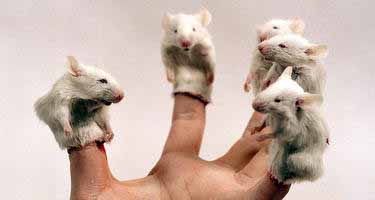
"Star" by Nathalia Edenmont
Is Poser Art?
by Jim Farris
So, you're looking at a Poser image. Quite possibly everythingin the scene can be purchased and downloaded, as well. It's digital collage.
But is it art?
Well, if it actually expresses the artist's thoughts or feelings, then yes, it's art. Art is self expression.
The question is often asked "Is Poser Art?" Are images generated by Poser (and other software) art?
Well, the answer is rather complex, and requires a quick and disgusting dive into what is considered art, today.
Nathalia Edenmont is considered an artist. She kills cats, mice, doves, rabbits and other animals, mutilates their bodies,and then takes their photographs. Finger puppets made from little white mice. A photo of a cat she beat to death with a stick, then mounted it's head and tail onto a vase. A stuffed toy rabbit with the head of a real rabbit sewn to it. Pictures of flowers with the eyes of real animals glued onto them, the eyes gouged outfrom their corpses. She's on exhibit, among other places, at the Wetterling Gallery in Sweden. She earns quite a comfortable living from her "art", and is world-renowned.

"Star" by Nathalia Edenmont
Point: If Nathalia Edenmont is considered "art" by the established art community, then certainly poser-generated artwork is "art" by any definition you care to use.
The question "What is art?" has been asked and debated for ages, likely since the first cave-man took a fire-charred stick and made a drawing of an antelope on a cave-wall.
In the 19th century, papiers collÚs was developed - what we today call "collage". The vast amount of printed material available in the 19th century, much of it material that was being thrown away (such as poster advertisements, magazines, newspapers, etc) allowed the development of a new art form. Yet, there were those who said that collage was not art. After all, anyone could make the same image with a set of scissors, some glue, and access to the same materials the artist had collected. By the 20th century, this was even more true, and the "cut and paste" works of artists like Max Ernst spawned a new term for the art form - collage.
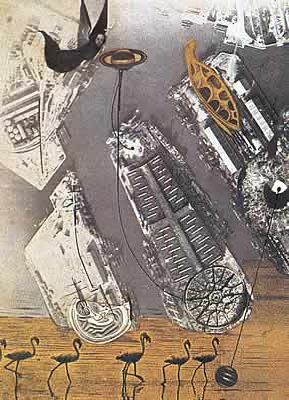
"The Comorants" by Max Ernst
At the dawn of the 20th century, there were many professional photographers who were trying to sell their images as"art." Many objected to calling photography art - afterall, the images they were producing were images literally anyone could produce, given the same equipment and standing in the same location. Where was the skill? Art, it was said, was what you managed to produce after years of training and more years of practice, using brushes, paints, and inks. Photography simply wasn't considered "art."
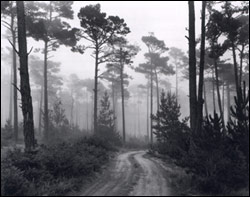
"Road and Fog" by Ansel Adams
Today, however, we recognize that photography IS art, just as collage is art. Regardless of the medium, art is a form ofself-expression.
Remember that. Burn it into your brain.
Art is self-expression.
Poser-generated art, as it is done by most poser users, is a form of digital collage. Yes, you downloaded the figure, downloaded the textures, maybe downloaded everything. Perhaps you bought some of it, perhaps some of it was free. But, then you put it together in an image that expresses what was on your mind at that moment. That is art. In fact, it's the root essence of what art is: Self-Expression.
Remember that. Burn it into your brain.
Art is self-expression.
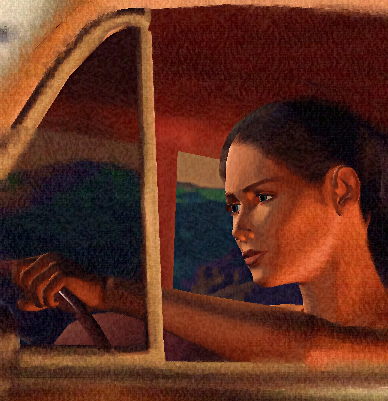
"Mystery Mama Cover Art" by
JimFarris
Whether you, the viewer, consider any work of art to be"art" isn't relevant. Art is self-expression. Poser art, by it's very definition, is digital collage. And collage is another means of artistic expression.
Now, whether you consider any piece of work to be"artistic" is another discussion. A work can be one of self-expression but lack any artistic merit - like Nathalia Edenmont's work. Her point with her art is that people kill animals every single day and never even think about it. Thousands of abandoned cats and dogs are euthanized, and countless millions of mice die in traps - yet no one sheds a tear (or so she says,PETA would disagree). Her point, that which she is trying to express with her photographs, is that the death of animals should not be treated casually.
Well, whether or not you agree with Nathalia's point, no one can possibly claim an image of her left hand with the carcasses of five mice stuck on her fingertips has any real artistic merit and not have ninety percent of the planet instantly and vehemently disagree. It is shocking, it is ugly, and it has no artistic merit. It is also hypocritical - she is commenting with her art about how people casually kill animals for their own benefit by casually killing animals for her own benefit.
Skill is, really, one of the easiest and most agreed-upon requirements for true artistic merit. It doesn't take any skill at all to chop a mouse in half, stuff the upper half atop one of your fingers, call it a finger-puppet, and take a picture to make a political point about animal rights. It requires no training or skill - it only requires one to be callous enough to kill an animal for the express purpose of creating art out of it's carcass. Hence, though it may be art, it has no artistic merit.
Similarly, it requires no training to take a pair of scissors, snip and clip images from magazines, and glue them together into a collage. No training or skill is required. Children can do it after only a minute's training to show them how to use scissors and glue. In fact, most people in the US have done collage as children when they were in kindergarten or grade-school.
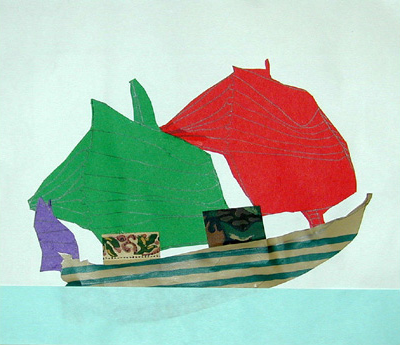
"Paper Collage Ship"
by"BB", age 8
As you can see, it is art, yes. In fact, the above collage is quite charming. But, it has no real artistic merit, because it took no skill to produce - it is the art of a child. We are not going to see this collage hanging in the Louvre someday.
Similarly, it requires no training or skill to purchase Poser, install it on your computer, run it, load up the figures that come with it, click one of the poses that come with it, click"render" and poof - an image. It may be art, yes,because you have expressed yourself. However, it has no artistic merit. I could train a chimp to click the buttons and do the same.
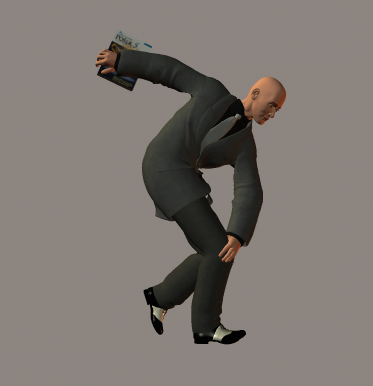
"Poser Man Tossing Poser Box" by
JimFarris
Now, like it or not, the above image is definitely art, because it expresses an opinion. I am just as fed up with cheap Poser art as any other individual who's ever spoken out against it. But, the image above has no artistic merit. It took no skill to create that image, I just clicked the buttons. The character,the box, and even the character's pose all came with Poser, my only input was to rotate the man ninety degrees so the lightwould shine on him from stage left.
Aside from the skill required to create the image, the other element of artistic merit is the emotional impact of the work. Indeed, the emotional impact of the work is, really, the largest part of whether or not the work has artistic merit. Does it resonate with you, the viewer? Do you look at it and think about it? Does your mind wander, wondering what lies just beyond the borders of the image? A character seen in the image is looking at something "off-stage", with a certain expression on their face. Do you wonder what they're looking at, or wonder what they're thinking? Perhaps the character is looking directly at the viewer, with an angry expression on their face. Are they scowling at an enemy before them, or at you, the viewer?
That is the largest part of what gives a work artistic merit.You, the viewer, were drawn into the world presented by the image, even if only for a moment. It sparked your imagination. For a brief moment, you weren't "here", on planet Earth, looking at that image. You were "there", examining the world the artist has presented you. An image that does that, an image that can transport you from where you're sitting to the artist's world has artistic merit. And it doesn't matter whether it's a painting by Leonardo DaVinci, a collage by Max Ernst, or a Poser image by a modern artist.
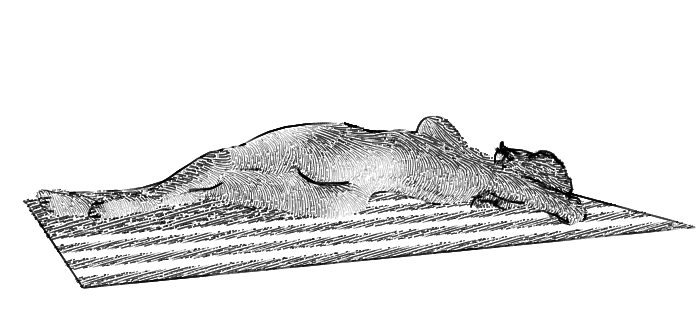
"Nude on Flag" by Jim Farris
Poser is essentially digital collage. The figures are downloaded, since very few people actually have the modeling skills to create their own figures. And more, backdrops, textures, props, and even poses are usually downloaded -sometimes purchased, but very often for free. But, when does this digital collage become art?
The largest problem with Poser artworks isn't that it's not art. The real problem with Poser art is that it has lowered the bar for performance. Consider, for example, the above image of the woman atop the flag. Twenty years ago, to create the above image would have required quite a bit of training and practice -likely years and years of practice at drawing.
Well, I created that image in Poser in sixty-eight seconds (I timed it), using only materials that came with the program.
In essence, the real problem with Poser isn't that what is created isn't art. Art is self-expression, and if a work expresses the artist's thoughts or feelings, then it's art. No,the real problem is that Poser (and other modern graphic arts programs) lowers the bar for artistic production, and raises the bar for artistic merit.
The bar for artistic production is lowered, because today, anyone can create the above image - all you need is Poser. Yet,at the same time, the bar for artistic merit is raised becausethere is so MUCH that is being produced, only the absolute best can stand above the rest as an artistic achievement.
Perhaps, twenty or thirty years from now, people will look back on the era of today and see the important contributions made to art by the digital artists of today. Raising the bar for achievement week by week, it seems inevitable that someday digital art will like digital photography, and the compositions are more and more evocative and elegant. They'll have to be, just to be considered artistic.
For now, however, remember:
Art is self expression. Thus, Poser is art.
Jim Farris,
Published Professional Author and Composer
http://www.jim-farris.com
xaa@3lefties.com
Note: All artworks displayed in this essay notof my own creation are displayed under the terms of Fair Use inUS Copyright Law - they are displayed expressly for the purposeof illustrating a point. Copyrights for these artworks are stillheld by their creators and/or their assigns.
Clickhere to visit my publisher's website.